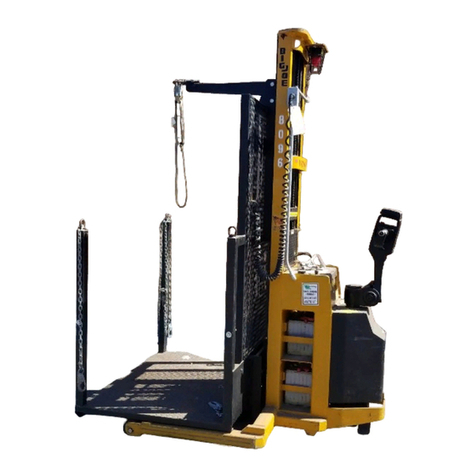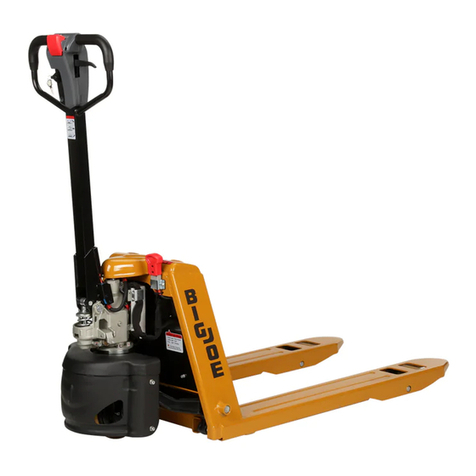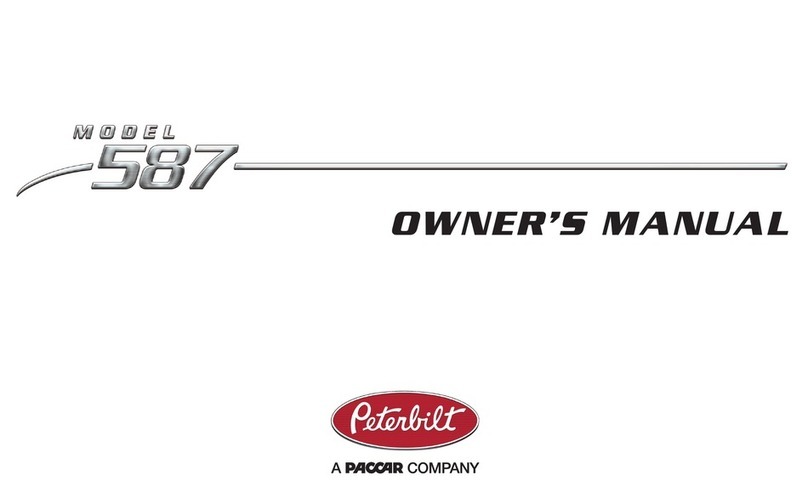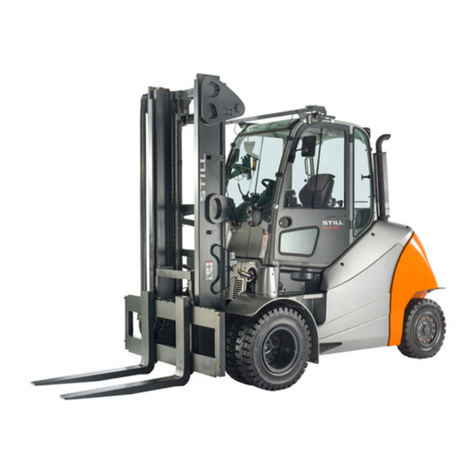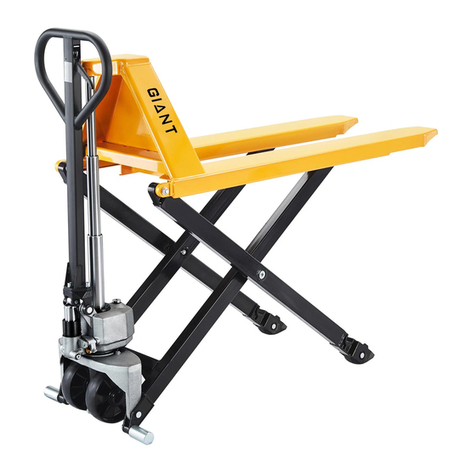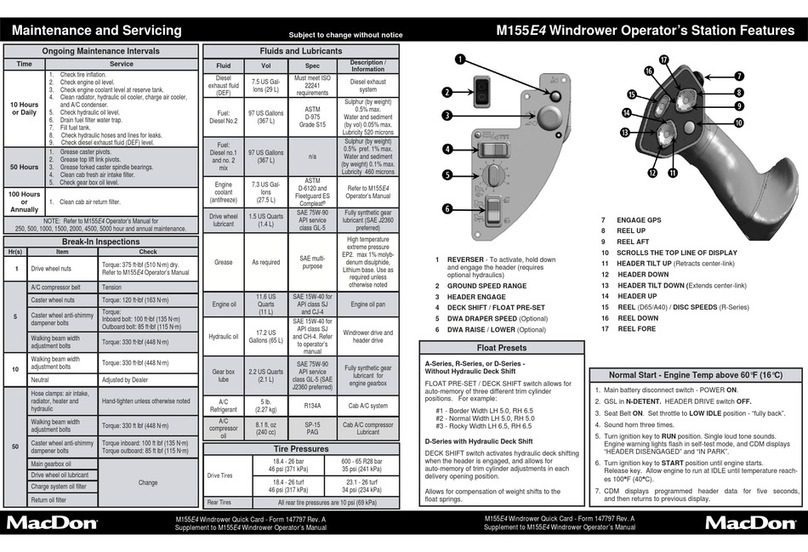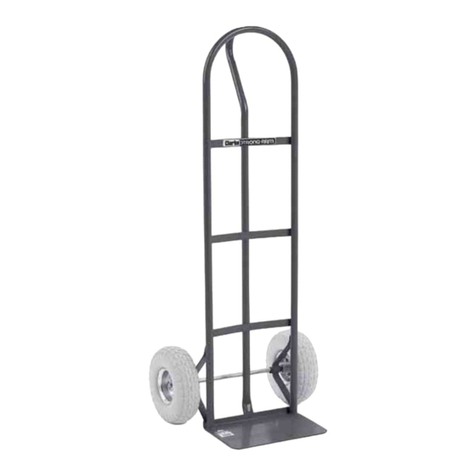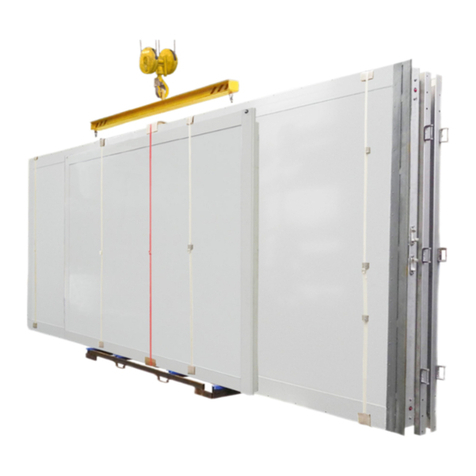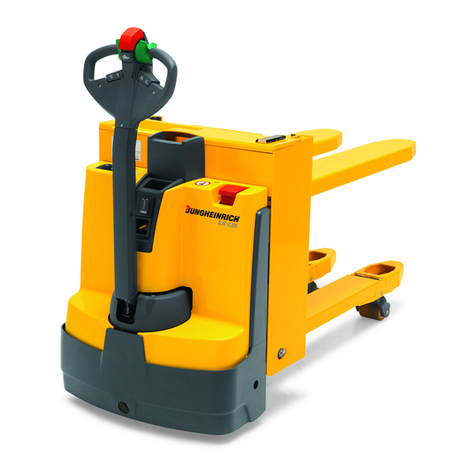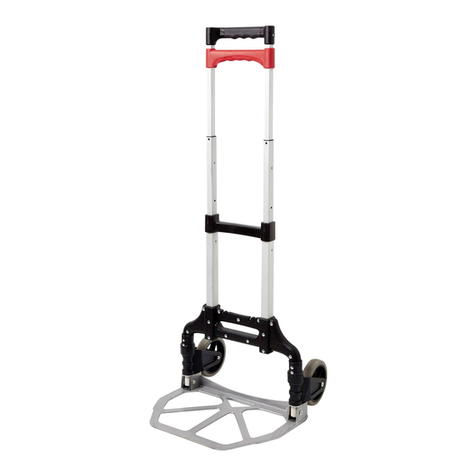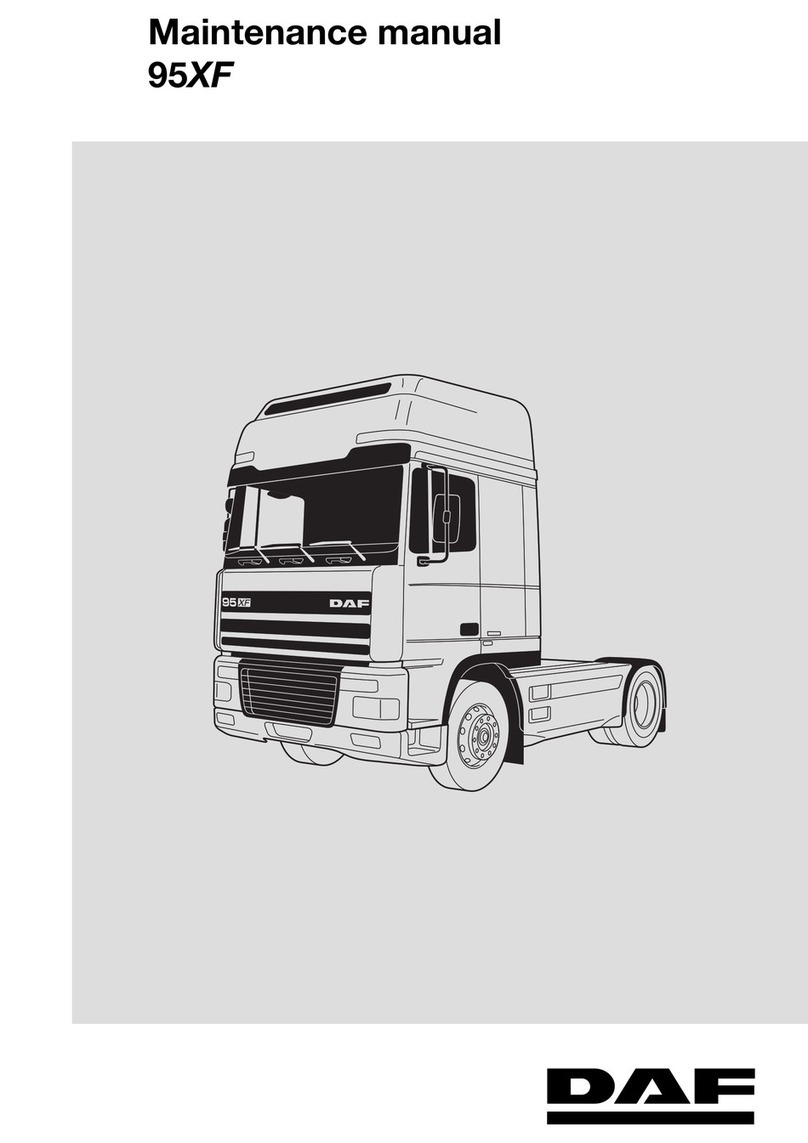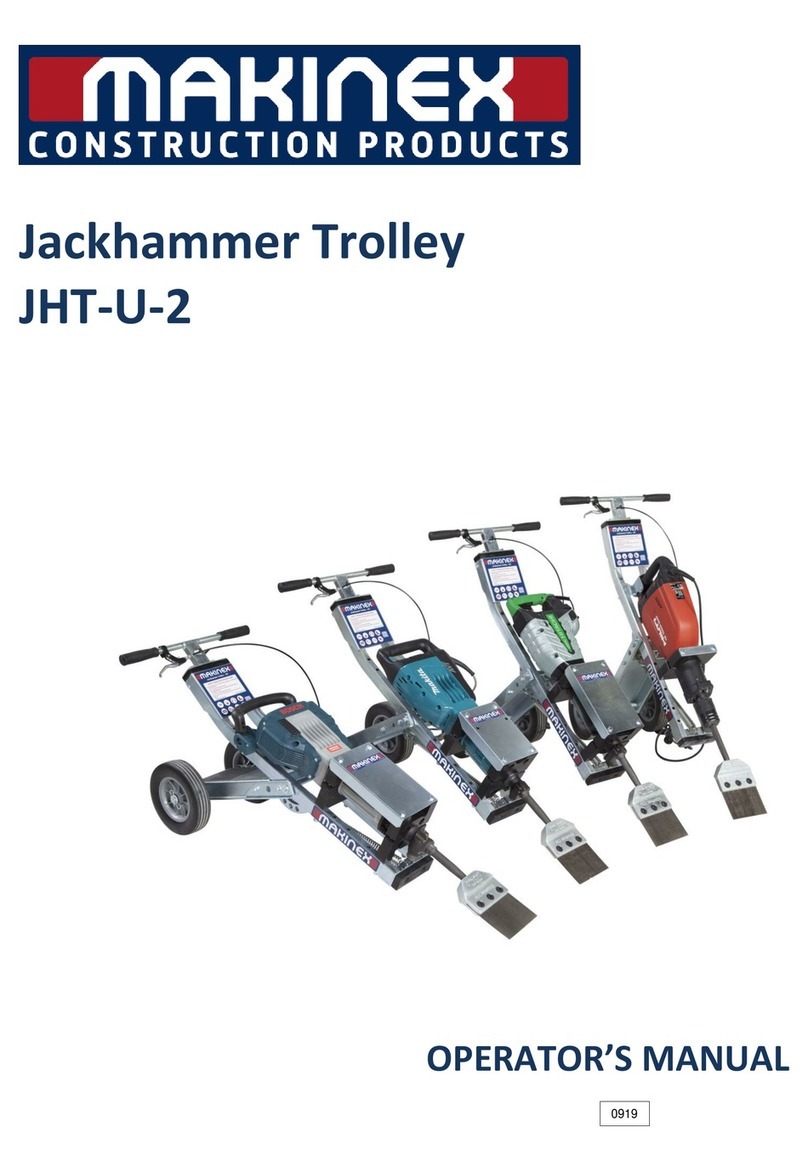Big Joe PDSR 30 Use and care manual

Big Lift LLC MANUAL NO. BL-PDSR 30-0319 - 03-07-2019
www.bigjoeforklifts.com
PDSR 30
POWER DRIVE REACH
LIFT TRUCK
Operation
Maintenance
Repair Parts List


TABLE OF CONTENTS
BL-PDSR 30-0319 - 03-07-2019 1
Section Page Section Page
1 DESCRIPTION ............................................................1-1
1-1 INTRODUCTION ................................................1-1
1-2 GENERAL DESCRIPTION .................................1-1
1-3 SAFETY FEATURES..........................................1-2
2 OPERATION ...............................................................2-1
2-1 GENERAL...........................................................2-1
2-2 OPERATING PRECAUTIONS............................2-1
2-3 BEFORE OPERATION.......................................2-2
2-4 GENERAL CONTROL OPERATION..................2-4
2-5 DRIVING AND
STOPPING PROCEDURES...............................2-4
2-5.1 STOPPING ................................................2-4
2-6 BELLY-BUTTON SWITCH .................................2-5
2-7 STEERING ARM GAS SPRING ........................2-5
2-8 LIFT AND LOWER CONTROLS........................2-5
2-9 LOADING AND UNLOADING.............................2-5
2-10 PARKING............................................................2-5
3 PLANNED MAINTENANCE ........................................3-1
3-1 GENERAL...........................................................3-1
3-2 MONTHLY AND QUARTERLY CHECKS..........3-1
3-3 BATTERY CARE ................................................3-1
3-3.1 GENERAL..................................................3-1
3-3.2 SAFETY RULES ........................................3-2
3-3.3 BATTERY CARE AND CHARGING...........3-2
3-3.4 BATTERY CLEANING ...............................3-2
3-4 CHARGING BATTERIES ..................................3-3
3-5 LUBRICATION...................................................3-3
3-6 LIFT CHAIN MAINTENANCE ............................3-3
4 TROUBLESHOOTING ................................................4-1
4-1 GENERAL...........................................................4-1
4-2 CONTROLLER TROUBLESHOOTING ..............4-4
4-2.1 ZAPI HANDSET (OPTIONAL) ...................4-4
4-2.2 FAULT DETECTION..................................4-4
4-2.2.1 GENERAL ............................................4-4
4-2.2.2 LOGBOOK ACCESS............................4-4
4-2.3 TESTING TRUCK OPERATION................4-4
4-2.4 SETTINGS AND ADJUSTMENTS.............4-5
4-2.4.1 SET OPTIONS .....................................4-5
5 OPERATING CONTROL SYSTEM .............................5-1
5-1 CONTROL HEAD ...............................................5-1
5-1.1 CAP ASSEMBLY REMOVAL.....................5-1
5-1.2 CAP ASSEMBLY INSTALLATION.............5-1
5-1.3 CONTROL HEAD REMOVAL....................5-1
5-1.4 CONTROL HEAD INSTALLATION............5-1
5-1.5 POTENTIOMETER REPLACEMENT ........5-1
5.1.6 BELLY-BUTTON
SWITCH REPLACEMENT.........................5-1
5-1.7 HORN SWITCH REPLACEMENT .............5-4
5-1.8 LIFT AND LOWER
SWITCH REPLACEMENT.........................5-4
5-2 COMPARTMENT COVERS ...............................5-4
5-2.1 REMOVAL .................................................5-4
5-2.2 INSTALLATION..........................................5-4
5-3 STEERING ARM................................................ 5-4
5-3.1 RETURN SPRING REPLACEMENT......... 5-4
5-3.2 STEERING ARM REMOVAL..................... 5-4
5-3.3 STEERING ARM INSTALLATION............. 5-4
6 BRAKE SERVICING ................................................... 6-1
6-1 BRAKES............................................................. 6-1
6-1.1 AIR GAP ADJUSTMENT........................... 6-1
6-1.2 STOPPING DISTANCE ADJUSTMENT.... 6-2
6-1.3 BRAKE ASSEMBLY REPLACEMENT...... 6-2
7 DRIVING SYSTEM ..................................................... 7-1
7-1 DRIVE WHEEL .................................................. 7-1
7-2 TRANSMISSION................................................ 7-1
7-3 STEERING MOTOR .......................................... 7-1
7-4 LOAD WHEEL.................................................... 7-1
7-4.1 REMOVAL................................................. 7-1
7-4.2 REPAIR ..................................................... 7-1
7-4.3 LOAD WHEEL INSTALLATION ................ 7-2
8 ELEVATION SYSTEM SERVICING ........................... 8-1
8-1 GENERAL .......................................................... 8-1
8-2 LIFT CHAIN LENGTH ADJUSTMENT............... 8-1
8-3 LIFT CHAIN WEAR INSPECTION..................... 8-2
8-4 LIFT CHAIN REPLACEMENT............................ 8-2
8-4.1 TELESCOPIC............................................ 8-2
8-4.2 TRIMAST FREE LIFT CHAIN.................... 8-4
8-4.3 TRIMAST SECONDARY LIFT CHAIN ...... 8-4
8-5 LIFT CYLINDERS .............................................. 8-4
9 HYDRAULIC SYSTEM SERVICING........................... 9-1
9-1 LINES AND FITTINGS....................................... 9-1
9-2 HYDRAULIC PUMP,
MOTOR AND RESERVOIR ............................... 9-6
9-2.1 REMOVAL................................................. 9-6
9-2.2 DISASSEMBLY AND REASSEMBLY ....... 9-6
9-2.3 INSTALLATION......................................... 9-6
9-2.4 LIFT CYLINDER (TELESCOPIC).............. 9-7
9-2.4.1 REMOVAL ........................................... 9-7
9-2.4.2 REPAIR ............................................... 9-7
9-2.4.3 INSTALLATION ................................... 9-7
9-2.5 LIFT CYLINDER (TRIMAST FREE LIFT).. 9-8
9-2.5.1 REMOVAL ........................................... 9-8
9-2.5.2 REPAIR ............................................... 9-8
9-2.5.3 INSTALLATION ................................... 9-9
9-2.6 LIFT CYLINDER
(TRIMAST SECONDARY)......................... 9-9
9-2.6.1 REMOVAL ........................................... 9-9
9-2.6.2 REPAIR ............................................... 9-9
9-2.6.3 INSTALLATION ................................. 9-10
9-2.7 REACH CYLINDER................................. 9-10
9-2.7.1 REMOVAL ......................................... 9-10
9-2.7.2 REPAIR ............................................. 9-10
9-2.7.3 INSTALLATION ................................. 9-15
9-2.8 TILT CYLINDER...................................... 9-15
9-2.8.1 REMOVAL ......................................... 9-15
9-2.8.2 REPAIR ............................................. 9-15

TABLE OF CONTENTS - CONTINUED
1-2 BL-PDSR 30-0319 - 03-07-2019
9-2.8.3 INSTALLATION ................................. 9-18
Section Page Section Page
10 ELECTRICAL COMPONENTS ................................. 10-1
10-1 ELECTRICAL CONTROL PANEL.................... 10-1
10-1.1 MAINTENANCE ...................................... 10-1
10-1.2 CLEANING .............................................. 10-1
10-1.3 PANEL REMOVAL .................................. 10-1
10-1.4 PANEL DISASSEMBLY .......................... 10-1
10-1.5 PANEL INSTALLATION .......................... 10-1
10-2 HORN REPLACEMENT................................... 10-1
10-3 PUMP MOTOR.................................................10-5
10-4 DRIVE MOTOR ................................................10-5
10-5 DEADMAN SWITCH ........................................10-5
11 OPTIONAL EQUIPMENT..........................................11-1
11-1 LOAD BACKREST ...........................................11-1
12 ILLUSTRATED PARTS BREAKDOWN ....................12-1

BL-PDSR 30-0319 - 03-07-2019 1-1
SECTION 1
DESCRIPTION
1-1. INTRODUCTION.
.This publication describes the 24 volt lift truck distrib-
uted by Big Lift LLC. Included are operating instruc-
tions, planned maintenance instructions, lubrication
procedures, corrective maintenance procedures and a
complete parts list with part location illustrations.
Users shall comply with all requirements indicated in
applicable OSHA standards and current edition of
A.N.S.I. B56.1 Part II.By following these requirements
and the recommendations contained in this manual,
you will receive many years of dependable service
from your PDSR lift truck
The model number will be found on the name plate
(Figure 1-1) along with the serial number, lifting capac-
ity, and load center. Figure 1-2 shows the locations of
the trucks main components and controls.
1-2. GENERAL DESCRIPTION.
The self-propelled truck, (Figure 1-2), lifts and transp-
orts payloads up to 3000 pounds on rigid forks.
4 feet without changing the overall lift height. Then the
mast will start to rise. However, if the truck has an
optional load backrest, the backrest will raise above
the mast before the end of the full free lift.
The forward and reverse motion is controlled by either
of two controller levers mounted on the control
head.Stopping and turning is controlled by the steering
arm.Lift and Lower is controlled by pushbuttons on the
control head. The battery powered lift truck is quiet
and without exhaust fumes.
The reversible AC motor propels the lift truck in for-
ward or reverse direction throughout the available
speed range. The PDSR lift truck can be driven with
forks raised or lowered; however, the speed is restri-
cted when the platform is raised above a preset limit.
The model number will be found on the name plate
(Figure 1-1) along with the serial number, lifting capac-
ity, and load center. Figure 1-2 shows the locations of
the truck's main components and controls.
Figure 1-1 Name Plate
R6209

1-2 BL-PDSR 30-0319 - 03-07-2019
1-3. SAFETY FEATURES.
The PDSR is designed engineered to provide maxi-
mum safety for operator and payload. Some of the
safety features incorporated into the design are:
• Dead-man brake to apply the brake and cut off drive
power when the steering arm is released.
• Belly-button switch to reverse truck should the oper-
ator accidentally pin himself against a wall or
obstruction when backing up in slow speed.
• High speed limit switch to restrict speed when lift
carriage is raised above the preset limit.
• All control functions automatically return to "OFF"
when released.
• Externally accessible battery disconnect within oper-
ator's reach.
• Separately fused control circuits and power circuits.
• Readily accessible horn button.
• Lift carriage backrest to help stabilize the load.
• Handle to provide a firm hand hold for operator.
• Flow control valve regulates maximum lowering
speed within prescribed limits.
• Relief valve maintains hydraulic pressure within pre-
scribed limits.
• High visibility color scheme of truck provides visual
alert of truck's presence.
• Battery Indicator.
• Stabilizers.

BL-PDSR 30-0319 - 03-07-2019 1-3
Figure 1-2 PDSR Lift Truck
Pos. Component Pos. Component
1 CONTROL HANDLE 7 FORKS
2 WINDSHIELD 8 COVER
3 LIFT CYLINDER 9 STABILIZERS
4 KEY SWITCH 10 DRIVE WHEEL
5 BATTERY INDICATOR 11 BATTERY PLUG
6 EMERGENCY DISCONNECT 12 REACH ASSEMBLY
R3930

1-4 BL-PDSR 30-0319 - 03-07-2019
NOTES

BL-PDSR 30-0319 - 03-07-2019 2-1
SECTION 2
OPERATION
2-1. GENERAL.
This section gives detailed operating instructions for
the lift truck. The instructions are divided into the vari-
ous phases of operations, such as operating lift, driv-
ing, and stopping. Routine precautions are included
for safe operation
2-2. OPERATING PRECAUTIONS.
WARNING: Improper operation of the lift truck may
result in operator injury, or load and/or lift
truck damage. Observe the following
precautions when operating the lift truck.
The following safety precautions must be adhered to
at all times.
• Do not operate this truck unless you have been
trained and authorized to do so.
• All warnings and instructions must be read and
understood before using the equipment.
• Equipment must not be altered in any way.
• Equipment must be inspected by a qualified person
on a regular basis.
• Do not exceed the rated capacity. Overloading may
result in damage to the hydraulic system and struc-
tural components.
• Be certain that the lifting mechanism is operating
smoothly throughout its entire height, both empty
and loaded.
• Be sure that mast is vertical - do not operate on a
side slope.
• Be sure the truck has a firm and level footing.
• Avoid overhead wires and obstructions.
• Check for obstructions when raising or lowering the
lift carriage.
• Do not handle unstable or loosely stacked loads.
Use special care when handling long, high, or wide
loads to avoid tipping, loss of load, or striking bysta-
nders.
• Center and carry the load as far back as possible
toward the lift carriage back rest. The center-of-
gravity of the load must not exceed the load center
listed on the nameplate. See Figure 2-1 for load cen-
ter limitations.
• Pick up loads on both forks. Do not pick up on only
one fork.
• When traveling, always lower the load as far as pos-
sible.
• When stacking pallets in racks and it is necessary to
move the load in a raised position, use caution.
Operate truck smoothly.
• Observe applicable traffic regulations. Yield right of
way to pedestrians. Slow down and sound horn at
cross aisles and wherever vision is obstructed.
• Operate truck only from designated operation posi-
tion.Never place any part of your body between the
mast uprights. Do not carry passengers.
• Do not allow anyone to stand or pass under load or
lifting mechanism.
• When leaving truck, neutralize travel control. Fully
lower lifting mechanism and set brake. When leaving
truck unattended, turn off key switch, remove key
and disengage the emergency stop switch.
Figure 2-1 Load Center
R3814

2-2 BL-PDSR 30-0319 - 03-07-2019
2-3. BEFORE OPERATION
Table 2-1 covers important inspection points on the
PDSR lift truck which should be checked prior to oper-
ation.Depending on use, some trucks may require
additional checks.
Figure 2-2 shows a sample format for an Operator
Checklist, which can be modified as necessary to fit
your operation.
WARNING: Periodic maintenance of this truck by a
UALIFIED TECHNICIAN is required.
CAUTION: A QUALIFIED SERVICE TECHNICIAN
should check the truck monthly for
proper lubrication, proper fluid levels,
brake maintenance, motor maintenance
and other areas specified in the SEC-
TION 3.
WARNING: If the truck is found to be unsafe and in
need of repair, or contributes to an
unsafe condition, report it immediately to
the designated authority. Do not operate
it until it has been restored to a safe
operating condition. Do not make any
unauthorized repairs or adjustments. All
service must be performed by a qualified
maintenance technician.
Table 2-1 Operator Checks
ITEM PROCEDURE
Transmission and
hydraulic systems.
Check for signs of fluid leak-
age.
Forks
Check for cracks and dam-
age; and, that they are prop-
erly secured.
Chains, cables and
hoses
Check that they are in place,
secured correctly,functioning
properly and free of binding or
damage.
Guards and load
backrest
Check that safety guards are in
place, properly secured and
not damaged.
Safety signs
Check that warning labels,
nameplate, etc., are in good
condition and legible
Horn Check that horn sounds when
operated
Steering Check for binding or looseness
in steering arm when steering.
Travel controls
Check that speed controls on
control head operate in all
speed ranges in forward and
reverse and that belly button
switch functions.
Wheels
Check drive wheel for cracks
or damage. Move truck to
check load for freedom of rota-
tion.
Hydraulic controls
Check operation of lift and
lower to their maximum posi-
tions.
Brakes
Check that brakes actuate
when steering arm is raised to
upright position, and when low-
ered to horizontal position.
Deadman/ Parking
brake
Check that steering arm raises
to upright position when
released and brake applies.
Emergency Stop
Switch
Check that emergency stop
switch can be disengaged and
reengaged.
Battery charge Check the battery indicator.
High speed limit
switch
Allow for enough space to
operate truck in high speed.
Elevate forks approximately
two feet, then test drive truck
to check if high speed is cut
out
ITEM PROCEDURE

BL-PDSR 30-0319 - 03-07-2019 2-3
Figure 2-2 Sample of Operator Check List
R3815

2-4 BL-PDSR 30-0319 - 03-07-2019
2-4. GENERAL CONTROL OPERATION.
The speed control (See Figure 2-3) located on each
side of the control head provides fingertip control for
driving the truck. Rotate the control in the direction
you want to travel. The farther you rotate the control
from the neutral position,the faster the truck will
travel.
Figure 2-3 Forward / Reverse Control
The pushbutton switches (See Figure 2-4), located on
the front of the control head activate the lift-lower con-
trols and the horn.
Figure 2-4 Pushbutton Switches
2-5. DRIVING AND STOPPING PROCEDURES
1. Connect the battery and turn on the key switch.
Grasp the grips of the steering head so that the
speed control can be comfortably operated by
either thumb.
2. Lower the steering arm to a comfortable position
above horizontal to disengage the brake and to
energize the electrical circuits.If the truck is not
moved, the electrical circuits will time out and will
deenergize. See.
3. To move forward (with load in back), slowly press
the speed control forward. See Figure 2-3. Press
the forward speed control farther to increase
speed.
4. To slow down or stop, release the speed control
and lower or raise the steering arm to the horizon-
tal or vertical position. In those positions, the
brake engages, slowing or stopping the truck.
5. Procedures for movement in reverse are the
same as in the forward direction except slowly
press the speed control backward.
2-5.1. Stopping
The stopping distance of the truck depends on the
ground conditions.The driver must take this into
account when operating the truck.
The driver must be looking ahead when traveling.
If there is no hazard,brake moderately to avoid
moving the load.
There are four different ways to stop the truck:
1. Plugging: This electrical braking function con-
sists of rotating the speed control lever in the
opposite direction of travel and then releasing it
when the truck stops. Plugging is a convenient
way to slow down the truck during normal
operation.If the control is not released, the truck
will accelerate in the opposite direction.
2. Steering arm (See Figure 2-5): The brake is fully
applied by lowering or raising the steering arm.
(See Figure 2-5) All traction control power is shut
off when the brake is engaged. When the steering
arm is in the upright position, the brake acts as a
parking brake. Deadman braking occurs when the
handle is released and spring action raises steer-
ing arm to the upright position.
3. Emergency braking: Press the emergency
brake switch, all electrical functions are cut out
and the truck automatically brakes.
4. Regenerative braking: If the speed control lever
is released, the truck automatically brakes regen-
eratively.When the speed is below.5 MPH, the
brake applies.
R8120
R8121

BL-PDSR 30-0319 - 03-07-2019 2-5
Figure 2-5 Brake Actuation
2-6. BELLY-BUTTON SWITCH
The belly-button switch (Figure 2-6) minimizes the
possibility of the driver being pinned by the steering
arm while driving the lift truck in slow speed.If the
switch presses against the operator while the lift
truck is being driven toward the operator,the switch
changes the direction of the lift truck.
Figure 2-6 Belly Button Switch
2-7. STEERING ARM GAS SPRING
The steering arm gas spring automatically raises the
steering arm to the upright position when the
steering arm is released.If the steering arm does not
return fully, the steering arm gas spring requires
replacement.Return truck to maintenance for repair.
2-8. LIFT AND LOWER CONTROLS
Lift/Lower Control buttons are located on the steering
control head. (Figure 2-4)
To lift forks, push in either LIFT button and hold until
forks reach desired height.To lower forks, push in
either LOWER button and hold until forks descend to
desired height.
2-9. LOADING AND UNLOADING
1. Move truck to location where load is to be picked
up.
2. Move the truck into position so forks are within
pallet or skid, and the load is centered over the
forks and as far back as possible.
3. Raise forks to lift load.
4. Drive to area where load is to be placed.
5. Move truck to align load with its new position.
6. Lower the load until it rests squarely in place and
the forks are free.
7. Slowly move the truck out from under the load.
2-10. PARKING
When finished with moving loads,return the truck
to its maintenance or storage area. Turn off the key
switch and disconnect the battery. Charge battery as
necessary.Refer to battery care instructions, SEC-
TION 3.
R8122
R8123

2-6 BL-PDSR 30-0319 - 03-07-2019
NOTES

BL-PDSR 30-0319 - 03-01-2019 3-1
SECTION 3
PLANNED MAINTENANCE
3-1. GENERAL.
Planned maintenance consists of periodic visual and
operational checks, parts inspection, lubrication, and
scheduled maintenance designed to prevent or
discover malfunctions and defective parts. The
operator performs the checks in SECTION 2,and
refers any required servicing to a qualified mainte-
nance technician who performs the scheduled mainte-
nance and any required servicing.
3-2. MONTHLY AND QUARTERLY CHECKS
Table 3-1 is a monthly and quarterly inspection and
service chart based on normal usage of equipment
eight hours per day,five days per week.If the lift
truck is used in excess of forty hours per week,
the frequency of inspection and service should be
increased accordingly.These procedures must be
performed by a qualified service technician or your
EP Service Representative.
3-3. BATTERY CARE
3-3.1. General
The PDSR may be equipped with maintenance free
or industrial wet cell batteries.
The care and maintenance of the battery is very
important to obtain efficient truck operation and
maximum battery life.
CAUTION: Gases produced by a battery can be
explosive. Do not smoke, use an open
flame, create an arc or sparks in the
vicinity of the battery. Ventilate an
enclosed area well when charging.
CAUTION: Batteries contain sulfuric acid which may
cause severe burns. Avoid contact with
eyes, skin or clothing. In case of contact,
flush immediately and thoroughly with
clean water. Obtain medical attention
when eyes are affected. A baking soda
solution (one pound to one gallon of wat-
er) applied to spilled acid until bubbling
stops, neutralizes the acid for safe hand-
ing and disposal.
Leakage voltage from battery terminals to battery
case can cause misleading trouble symptoms with
the truck electrical system.Since components of
the truck electrical system are insulated from truck
frame, leakage voltage will not normally affect truck
operation unless a short circuit or breakdown of
circuit wire insulation to truck frame occurs.
A voltage check from battery connector terminal
to battery case should indicate near zero volts.
Typically, however,the sum of the voltages at both
terminals will equal battery volts. This leakage
voltage will discharge the battery. As battery
cleanliness deteriorates,the usable charge of the
battery decreases due to this self discharge.
Although a leakage voltage reading of zero volts
may not be possible, a cleaner battery will have
more usable charge for truck operation and not affect
operation of electronic devices on the unit.
Table 3-1 Monthly and Quarterly Inspection and Service Chart
VISUAL CHECKS
INTERVAL INSPECTION OR SERVICE
Monthly Check electrical brake for proper operation.
Monthly Check load wheels for wear.A poly load wheel must be replaced if worn to within 1/16 inch
of hub. Check for separation from hub.
Monthly Check drive wheel for wear.A poly drive wheel must be replaced if worn to within 3/4 inch
of hub. Check for separation from hub.
Monthly Inspect wiring for loose connections and damaged insulation.
Monthly Inspect contractors for proper operation.
Monthly Check deadman brake switch for proper operation.
Monthly Check lift chain tension, lubrication & operation (see paragraph 3-6.)
Quarterly Check lift cylinder for leakage.
Quarterly Check for excessive jerking of steering arm when stopping or starting.
Semi-annually Inspect for chain wear (See SECTION 8)

3-2 BL-PDSR 30-0319 - 03-01-2019
3-3.2. Safety Rules
•Wear protective clothing, such as rubber apron,
gloves, boots and goggles when performing any
maintenance on batteries. Do not allow electrolyte
to come in contact with eyes, skin, clothing or floor
.
If
electrolyte comes in contact with eyes,flush
immediately and thoroughly with clean water.
Obtain medical attention immediately. Should
electrolyte be spilled on skin, rinse promptly with
clean water and wash with soap.A baking soda
solution (one pound to one gallon of water) will
neutralize acid spilled on clothing, floor or any
other surface. Apply solution until bubbing stops
and rinse with clean water.
• If truck is equipped with wet cell batteries,keep vent
plugs firmly in place at all times except when adding
water or taking hydrometer readings. Do not allow
dirt, cleaning solution or other foreign material to
enter cells. Impurities in electrolyte has a neutraliz-
ing effect reducing available charge.
•Do not bring any type of flame, spark, etc., near the
battery.Gas formed while the battery is charging, is
highly explosive. This gas remains in cell long after
charging has stopped.
• Do not lay metallic or conductive objects on battery.
Arcing will result.
•Do not touch non-insulated parts of DC output
connector or battery terminals to avoid possible
electrical shock.
• De-energize all AC and DC power connections
before servicing battery.
• Do not charge a frozen battery.
• Do not use charger if it has been dropped or other-
wise damaged.
3-3.3. Battery Care and Charging
CAUTION: Never smoke or bring open flame near
the battery.Gas formed during charging
is highly explosive and can cause seri-
ous injury.
1. Charge the battery only in areas designated for
that use.
2. Make certain the charger being used matches the
voltage and amperage of the truck battery.
3. Before disconnecting or connecting batteries to a
charger,make sure the charger is “OFF”. If an
attempt is made to do this while the charger is
“ON”, serious injury to you,the battery and the
charger could result.
4. Before connecting the battery cable to the trucks
receptacle,make sure the key switch is off. The
battery cable must be fully connected before the
truck is used. If the plug is not making good con-
tact, heat will weld the two parts of the battery
connector together,making it difficult to remove
and necessary to replace.
5. Battery terminals should be checked and cleaned
of corrosion regularly.Good battery terminal con-
tact is essential not only for operation, but also for
proper charging of the battery.
6. The charging requirements will vary depending on
the use of the truck. The battery should be given
as equalizing charge on a weekly basis.This
charge should normally be an additional three
hours at the finish rate.
7. Make certain battery used meets weight and size
requirements of truck. NEVER operate truck with
an undersized battery.
3-3.4. Battery Cleaning
Always keep vent plugs tightly in place when
cleaning battery. When properly watered and
charged,the battery will remain clean and dry. All
that is necessary is to brush or blow off any dust
or dirt that may accumulate on them.However,
if electrolyte is spilled or overflows from a cell, it
should be neutralized with a solution of baking soda
and water, brushing the soda solution beneath the
connectors and removing grime from the covers.
Then rinse the battery with cool water from a low
pressure supply to remove the soda and loosen dirt. If
batteries stay wet consistently,they may be either
overcharged or over filled. This condition should be
investigated and corrected.

BL-PDSR 30-0319 - 03-01-2019 3-3
3-4. CHARGING BATTERIES
Charging requirements will vary depending on depth
of discharge and temperature. Follow safety rules
when placing a battery on charge.
Proceed as follows:
1. Park truck at charging station with carriage low-
ered and turn the key switch off.
2. Check the condition of the AC cord and battery
cables.If there are any cuts in the cable,any
exposed wires, loose plugs or connectors, DO
NOT attempt to charge the batteries.Contact
appropriate personnel for repairs to be made.
3. Disconnect the batteries from the truck and con-
nect the batteries to the charger.Make sure
connectors are mated properly.
4. Connect the charger to the appropriate power
supply.
5. Follow the instructions for the charger being used.
3-5. LUBRICATION
Refer to Table 3-2 for the recommended types of
grease and oil. Table 3-3 in conjunction withFigure
3-1 identifies the items requiring lubrication.
3-6. LIFT CHAIN MAINTENANCE
Fully raise and lower lift carriage while observing
chains as they move over chain sheaves. Ensure
chain is aligned and tracking properly and all links
are pivoting freely. With lift carriage fully lowered,
spray or brush on a film of SAE 30 or 40 engine oil
Table 3-2 Recommended Lubricants (See Table 3-3 for Application)
No. 1 Transmission oil- 85W-90
Transmission oil-10W-30 (NOTE)
No. 2 Grease-Lithium base, general purpose.
No. 3 Hydraulic oil-Heavy duty with a viscosity of 150 SUS foam suppressing agent and rust and
oxidation inhibitors
Hydraulic oil-Heavy duty with a viscosity of 100 SUS foam suppressing agent and rust and
oxidation inhibitors (NOTE)
No. 4 SAE 30 or 40 Engine lubricating oil.
NOTE: USED ON COLD CONDITIONED TRUCKS

3-4 BL-PDSR 30-0319 - 03-01-2019
Figure 3-1 Lubrication Diagram
Table 3-3 Lubrication Chart
Pos. Location Method of
Application
TYPE
(Table3-2) APPLICATION OF LUBRICANT
1Transmission Capacity - 1.75 Liters Can No. 1 Fill to level plug opening.
2 Inner & Outer Mast Brush No.2 Full length of channel where rollers
operate.
3
Hydraulic Reservoir:
Capacity - 13.78 Liters (L.H. 2600mm)
Capacity - 14.91 Liters (L.H. 3200mm)
Capacity - 16.86 Liters (L.H.4000mm)
Can No. 3
With lift carriage fully lowered, fill res-
ervoir with hydraulic oil to 1 inch
below opening.
4Lift Chain Brush or Spray No. 4 See Paragraph 3-6
R8124

BL-PDSR 30-0319 - 03-07-2019 4-1
SECTION 4
TROUBLESHOOTING
4-1. GENERAL
Use Table 4-1. as a guide to determine possible
causes of trouble. The table is divided into five main
categories: Truck and Hydraulic System Will Not
Operate:
Truck Does Not Operate Forward or Reverse: Trouble
With Braking: Trouble With Lifting Or Lowering, and
Miscellaneous malfunctions.
Table 4-1. Troubleshooting Chart
MALFUNCTION PROBABLE CAUSE CORRECTIVE ACTION
TRUCK AND HYDRAULIC
SYSTEM WILL NOT OPERATE
Truck will not travel not will lift sys-
tem operate.
a. Fuse blown. Check fuse and replace if neces-
sary.
b.
Fuse blown. Check fuse and replace if neces-
sary.
c. Battery dead or disconnected. Check battery connections and
check battery voltage.
d. Key switch defective Bypass key switch to determine if
it is malfunctioning.
e. Emergency brake switch defective. Bypass the switch to determine if it
is malfunctioning.
f. Defective wiring. Check for open circuit. Repair as
required
TRUCK DOES NOT OPERATE
FORWARD OR REVERSE
Truck does not travel forward or
reverse. All other functions operate
normally.
a. Check all wiring. A loose connec-
tion may be the cause of mal-
function.
Tighten all loose connections
before further troubleshooting.
b. Defective deadman switch. Check and replace switch if defec-
tive.
c. Defective main controller. Check for proper operation and
replace if necessary.
d. Defective potentiometer in control
head.
Check and replace potentiometer
if defective.
Truck travels forward but not in
reverse.
Defective potentiometer in control
head.
Check and replace potentiometer
if defective.
Truck travels reverse but not in
forward.
Defective potentiometer in control
head.
Check and replace potentiometer
if defective.

4-2 BL-PDSR 30-0319 - 03-07-2019
Truck travels forward and in reverse
at lower speeds; will not travel at
high speed.
Defective potentiometer in control
head.
Check and replace potentiometer
if defective.
TROUBLE WITH BRAKING
Truck does not slow with brake, or
brake does not engage.
a. Defective deadman switch.
Check deadman switch for conti-
nuity.If none found when the con-
trol arm is in the brake position,
replace switch.
b. Defective electric brake. Adjust or replace brake.
Brake will not release.
a. Defective electric brake. Replace.
b. Brake temperature above 281° F Allow to cool and check air gap.
c. Open brake circuitry or wiring. Make voltage checks.
Brake drags. Defective electric brake Replace.
Brake grabs.
a. Incorrect stopping distance adjust-
ment Adjust.
b. Defective electric brake. Replace.
Abnormal noise and chatter when
brake is applied. Defective electric brake Replace.
TROUBLE WITH LIFTING OR
LOWERING
Oil sprays or flows from the top of
the lift cylinder.Defective packing in lift cylinder. Repair lift cylinder.
Squealing sounds when lifting forks. a. Oil level too low.Identify oil leak and fill reservoir.
b. Lift linkage binding. Apply grease.
Forks do not lift to top. a. Oil level too low.Add oil to reservoir.
b. Load larger than capacity.Refer to I.D.plate for capacity.
Weak, slow or uneven action of
hydraulic system.
a. Defective pump or relief valve Check pressure. Adjust as neces-
sary.
b. Worn lift cylinder.Replace cylinder.
c. Load larger than capacity.Refer to I.D.platefor capacity.
d. Defective lift motor solenoid. Replace solenoid on pump motor.
e. Battery charge low.Charge battery.
MALFUNCTION PROBABLE CAUSE CORRECTIVE ACTION
Table of contents
Other Big Joe Truck manuals
